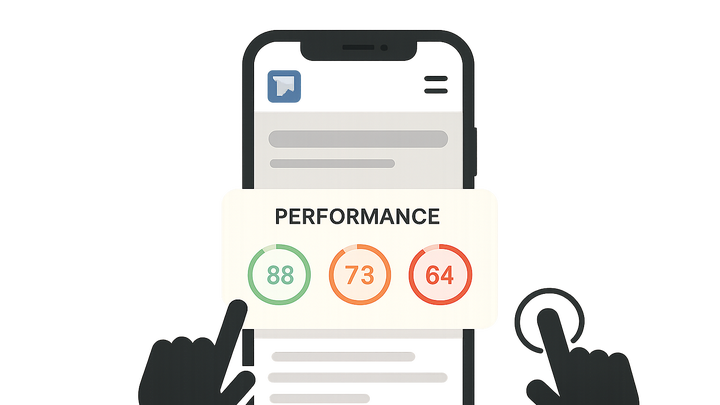Published on 2025-06-29T19:32:20Z
What is Mobile Optimization? Examples & Best Practices
Mobile optimization is the process of adapting a website’s layout, content, and performance to provide an optimal user experience on mobile devices. With more than half of global web traffic coming from smartphones, ensuring fast load times, intuitive navigation, and legible content on small screens is critical for engagement and conversions. In the context of CRO (Conversion Rate Optimization), UX (User Experience), and SEO (Search Engine Optimization), mobile optimization directly influences bounce rates, search rankings, and overall lead generation performance.
Key aspects of mobile optimization include:
- Responsive design that adapts seamlessly to various screen sizes
- Performance enhancements like asset compression and lazy loading
- Touch-friendly interfaces and prioritized content hierarchy
Tools like Prevue.me can provide actionable mobile-specific critiques to identify performance bottlenecks, UX issues, and SEO opportunities. By following best practices and leveraging the right tools, businesses can deliver faster, more engaging mobile experiences that drive conversions.
Mobile optimization
Adapting a website’s layout, performance, and usability for mobile devices to boost UX, SEO, and conversion rates.
Why Mobile Optimization Matters?
Mobile devices now account for over half of global web traffic. Optimizing for mobile is essential to meet user expectations, maintain SEO rankings under Google’s mobile-first indexing, and improve conversion rates. Poor mobile experiences lead to high bounce rates and lost revenue. By prioritizing mobile optimization, businesses ensure seamless navigation, faster load times, and better engagement. prevue.me provides actionable mobile-specific critiques to pinpoint issues and opportunities.
-
User behavior trends
Over 50% of web traffic originates from smartphones; users expect fast, intuitive mobile experiences.
-
Seo impact
Google’s mobile-first indexing prioritizes mobile versions of pages; slow or unresponsive sites are penalized in search rankings.
-
Conversion rates and revenue
Mobile-optimized sites see lower bounce rates and higher conversion rates, directly boosting lead generation and sales.
Core Components of Mobile Optimization
Effective mobile optimization requires attention to layout, performance, and usability tailored to smaller screens and varying network conditions. The following components form the foundation of a mobile-ready site.
-
Responsive layouts
Use flexible grids and media queries to adjust content structure across different screen sizes.
- Fluid grids:
Grid systems that adapt to viewport changes using relative units.
- Flexible images:
Images and media that resize or compress based on device capabilities.
- Fluid grids:
-
Performance optimization
Minimize page load times through efficient coding, asset compression, and caching strategies.
- Asset compression:
Compress images, CSS, and JavaScript to reduce payload size.
- Lazy loading:
Defer offscreen images and media until they are needed.
- Asset compression:
-
Touch-friendly interfaces
Design UI elements with adequate spacing and size to accommodate finger taps.
- Tap targets:
Ensure buttons and links are at least 48x48 pixels for easy tapping.
- Gesture support:
Implement swipe or scroll gestures for intuitive navigation.
- Tap targets:
-
Content prioritization
Streamline content hierarchy to highlight essential information and CTAs on small screens.
- Progressive disclosure:
Show key details first and hide secondary content behind interactions.
- Progressive disclosure:
Best Practices & Implementation Steps
Follow a structured approach to optimize your site for mobile. Regular audits and iterative improvements ensure sustained performance gains and user satisfaction.
-
Conduct a mobile audit with prevue.me
Leverage prevue.me to receive targeted critiques on CRO, UX, SEO, and accessibility specific to the mobile experience.
-
Implement a mobile-first design
Start designing for small screens, then progressively enhance for larger devices.
-
Optimize media assets
Compress images, serve WebP formats, and use responsive image attributes.
-
Improve rendering and loading
Inline critical CSS, defer non-essential scripts, and enable browser caching.
-
Test across devices and networks
Use emulation and real-device testing under various network speeds to identify and fix issues.
Tools and Resources
Utilize specialized tools to analyze, test, and enhance mobile optimization efforts quickly and effectively.
-
Prevue.me
Get actionable critiques for maximum lead generation, covering performance, UX, SEO, and accessibility on mobile.
-
Google lighthouse
Open-source tool for auditing performance, accessibility, and SEO metrics on mobile pages.
-
Pagespeed insights
Provides lab and real-world data on mobile performance along with optimization suggestions.
-
Browser devtools mobile emulation
Simulate mobile devices and network conditions to debug and optimize mobile experiences.
-
Webpagetest
Detailed performance testing with real mobile device locations and network throttling options.
